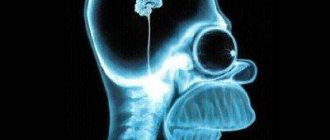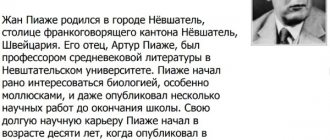Scientific research is an inexhaustible source of information on almost any topic, and this is especially true regarding human thinking. Thanks to the efforts of scientists, today even a completely ordinary person can learn about the brain and intelligence something that will help him become smarter, achieve success and expand his boundaries.
In our article “Development of thinking. What to do to become smarter,” we talked in detail about why you need to become smart in general, and even cited interesting statistics and scientific data. However, the information available to humanity today still leaves a lot of questions unanswered about how a person thinks, what thoughts are, what intelligence is made of, etc.
In our material today, we want to briefly tell you about ten interesting theories about human intelligence that scientists are studying. Some of them have already been refuted, others have been criticized, but it still cannot be ruled out that one day experts will find evidence of this or that theory, after which the understanding of intelligence and its mechanisms will radically change.
One way or another, we believe that this information may seem interesting to anyone who is engaged in self-development and strives to become smarter. It is quite possible that after reading this article you will have some new ideas that you can successfully use in your life.
Birth sequence
Scientists have been trying for decades to understand how birth sequence affects what affects a person's intelligence. But one of the latest studies conducted by the American Psychological Association states that there is no direct relationship between the order of birth of children in a family and their level of intelligence.
Not so long ago, experts believed that it was the first-born children who showed the best results in texts testing intelligence. They explained this by the lack of competition for the attention and care of parents, which allows children to devote more time to receiving and assimilating new information. And children who were born later, according to scientists, experienced a lack of parental care and, as a result, did not show such good results on tests.
As for the latest study specifically, it compared siblings without touching on birth order. And it was possible to establish that there is no significant relationship between birth order and mental characteristics.
Intelligence tests
IQ tests are typically used to assess cognitive abilities, intelligence quotient, and achievement levels. The most common are standard intelligence tests, such as the SAT (Academic Assessment Test) and the Stanford-Binet Test for Gifted Children. These tests evaluate a person's cognitive skills and compare them with those of the general population.
Such tests have been popular for decades among ordinary people, but despite this, today they are increasingly criticized. Some experts, for example, are convinced that there is a certain bias in these tests along various lines: racial, gender, cultural and socio-economic.
Such IQ tests are based on the no longer current idea that human intelligence is something that is determined at birth and does not undergo major changes throughout life. Therefore, scientists who share the opinion that the “old” tests are biased recommend that everyone who takes them not take their results too seriously.
V. INTELLIGENCE RESEARCH METHODS
The task of establishing the level of intelligence has been one of the most important in psychology since the formation of this science. It was the intellectual indicator of a person that made it possible to characterize his mental and moral qualities. The establishment of quantitative and qualitative dependencies of these indicators on the level of intelligence development made it possible to develop various methods for studying intelligence and related qualities. The assessment of intelligence as a specific human activity gave rise to methods similar to the Eysenck test. The establishment of its structure has given rise to a huge number of tests examining various aspects. This is how tests of logical, imaginative, creative and technical thinking appeared. Professional aptitude tests also turned out to be closely related to the level of intelligence. Moreover, to obtain a position as a US government employee, the applicant must show an IQ level of at least 100, and certification for a professional qualification category requires, in addition to demonstrating production skills, passing a whole set of similar tests.
The educational program of schools in the USA and other developed European countries includes the use of intelligence testing techniques as an evaluative, stimulating tool that causes additional motivational changes. Thus, an indicator of intelligence (not necessarily IQ) has become one of the most important indicators of human suitability for a particular activity, and ultimately the usefulness of a person as such.
It is necessary to distinguish between tests of intelligence development and tests of intelligence as such. The first, as a rule, includes questions of an educational nature, standardized tasks with a rigid structure. This group of techniques is designed to assess a person’s education, the speed and quality of his thinking, reaction speed and ability to switch from one type of activity to another. A person is tested only as a performer, tested on a standard scale without being able to stand out from the general scheme. The methods of the second group do not have this drawback; they determine the prevailing type of thinking, the methodology for finding a solution to the problem, non-standard approach, creative abilities, and the ability to operate with concepts. Such methods are never rigidly established; they are compiled on the basis of creative tests, tests of an intuitive nature, where not the speed, but the manner of solving a particular problem, the level of conceptual connections, non-standard thinking, and the effectiveness of the approach are assessed. However, such tests are not suitable for mass testing due to their purely individual nature, the complexity of the assessment and the large amount of time spent processing the result. In the generally accepted understanding, intelligence testing comes down to solving one or a series of tests that assess a person’s general educational level, that is, tests of the first group.
Intelligence research methods are roughly divided into: experimental, survey and creative (intuitive).
The first ones give the fastest and clearest results.
The latter allow a series of data that correlate with each other, but are a little more difficult to process.
The third type is placed in a special class; it is the most informative, but presents significant difficulties in processing the result and its interpretation; moreover, the results obtained using this group of techniques are not always clearly related to similar results from another group.
Below are examples from the first and second groups for the study of adults. To avoid ambiguous interpretations and a lot of theoretical justification.
Stanford–Binet tests
Among the many translations and adaptations of the Binet scales, one of the American versions, the Stanford edition, turned out to be the most viable.
The first edition, prepared by Theremin and his colleagues at Stanford University in 1916, introduced so many changes and additions to the original source that it essentially represented a new scale. It was in this variant that intelligence quotient (IQ), or the relationship between mental and chronological age, was first used. The third edition of the Stanford scale (1960) is still used today. Let's consider its main features.
The tests in it are grouped by age level: starting from 2 years old to 5 years old, they are located at semi-annual intervals; for ages from 5 to 14 years - annual intervals; the remaining levels are designated as intermediate adult and highest adult levels (1, 2, 3). The intervals between them are more than one year.
Each subject is presented only with those tasks that are addressed to his own age level. Typically, the testing procedure begins with tasks at a lower level than the expected mental age of the subject. The level at which he copes with all tasks is determined for the subject. This level is called basic age. Testing then continues until a level is found at which the subject fails on all tests. This level is called the age limit. Once this level is reached, testing ends.
Processing of individual tests of the Stanford-Binet scale occurs on an all-or-nothing basis. The manual for each test sets the minimum level of performance at which the test is considered completed. A subject's mental age on the Stanford-Binet scales is found by assigning him his basal age and adding a few months to that age for each correctly solved test above the basal level. Most Stanford-Binet tests are not suitable for adults because the nature of the tasks does not allow them to reach the age level ceiling.
The original definition called the psychological test a standardized measurement with reasonable reliability.
The problem of the validity of the Stanford-Binet tests is solved from different angles. Examination of the items offered in the tests provides some information regarding their validity. The content of these tasks ranges from simple manipulation to abstract reasoning. According to A. Anastasi (1S72), it can be argued that the Stanford scale is valid in content, since all the functions studied in it are relevant to what is usually considered as “mind”.
Validity, referred to as relevance to an external criterion, is determined primarily by correlations of mental proficiency derived from a scale with a variety of measures of school achievement. Most of these correlations are found in the literature to range from 0.40 to 0.75.
Scores on the Stanford scale also correlate quite highly with learning ability in higher education institutions (0.40-0.70).
The Stanford-Binet Scale served for many years as the only instrument for measuring intellectual ability, and was also used as a criterion for the validity of new intelligence tests. This largely explains the fact that IQ has come to be seen as a symbol of intelligence rather than a score on a specific test.
Wechsler test.
Another type of individual intelligence tests is represented by the Wechsler Intelligence Scales. These scales differ from the Stanford-Binet tests in several important ways that make them similar in form to group tests. Another characteristic feature of the Wechsler scales is the introduction of two types of techniques - verbal tests and performance tests (this is the name for tasks of a non-verbal, effective nature, for example, putting together a figure from parts, etc.).
Published in 1955, the Wechsler Adult Scale contains 11 tests. Six of them are grouped into the verbal scale and five into the performance scale. The verbal scale includes tasks that require awareness in certain areas of knowledge, comprehension tasks (the meaning of proverbs, behavior in certain circumstances, etc.), arithmetic tasks (within primary school), finding similarities, determining vocabulary, memorizing numbers. The performance scale includes tasks for completing pictures, constructing blocks (from cubes), arranging pictures in order, and some others.
Examples of tasks
1. General awareness.
2. General understanding.
3. Arithmetic reasoning.
4. Numbers forward and backward.
5. Similarity (The subject is asked to talk about how the following pairs are similar)
When performing tests, both speed and accuracy are taken into account.
Wechsler tests were standardized on a sample of 1,700 people (ages 16 to 64 years). The average IQ by choice is 100 with 10=15. Test reliability is high: for the full scale it is 0.97, for verbal tests - 0.96, for performance tests - 0.94.
Data on the validity of the Wechsler scale were obtained separately for verbal and performance tests. The correlation of performance test scores with job success among clerical workers is 0.30, and the correlation of verbal test scores with college performance does not exceed 0.50. In addition, validity testing was carried out by correlating the Wechsler scales with the Stanford-Binet scales. Coefficients of the order of 0.80 and lower were obtained.
Eysenck test
This test consists of eight subtests, five of which are intended to assess the general level of a person’s intellectual development, and three to assess the degree of development of his special abilities: mathematical, linguistic and those abilities that are needed in activities where figurative images are actively used. logical thinking.
Only if all eight subtests are completed can a full assessment be made of both the level of a person’s general intellectual development and the degree of development of his special abilities.
The test is given 30 minutes during which the test taker must answer the questions posed. Testing ends after the specified time has elapsed or when all 40 questions are answered.
Answers to tasks consist of one number, letter or word. The dots in the task indicate the number of letters in the missing word. For example (….) means that the missing word consists of four letters. The answer is written in the text line under the task or answer options in numbers or capital (small) letters of the Cyrillic alphabet (Russian alphabet). The subject is advised not to linger too long on one task and to remember that towards the end of the series the tasks generally become more difficult.
Normally, the minimum IQ level is 70, the maximum is 180. The average IQ level ranges from 100 to 120 points. In computer versions of the test, the result can be presented in the following table:
The assessment of the level of development of the corresponding abilities is made by the total number of problems correctly solved during this time by comparing the number of solved problems with standard indicators, which are then plotted in the form of graphs.
Chart No. 1 Chart No. 2
To assess linguistic abilities To assess mathematical abilities
Number of correctly solved problems Number of correctly solved problems
Having found, using the graph, the corresponding point on the lower axis, restoring a perpendicular from it to the intersection with the graph line and then lowering it from the point of intersection with the graph line and then lowering it from the intersection point to the vertical axis, you can determine the intellectual development coefficient of the subject for this type thinking.
Stimulus material for this material is widely presented in the literature and the Internet in the form of ready-made testing programs.
4. Progressive Raven matrices*
In 1936, Raven, together with Penrose, proposed the Progressive Matrices test to measure the level of development of general intelligence. The test tasks are based on the Gestalt theory and K. Spearman's theory of intelligence. It is assumed that the subject initially perceives the task as a whole, then identifies patterns of change in the elements of the image, after which the selected elements are included in the whole image, and the missing part of the image is found.
Abstract geometric shapes with a pattern organized in a certain way were chosen as the material.
Three main versions of the test have been designed: 1) a simpler, color test, intended for children from 5 to 11 years old; 2) black and white version for children and adolescents from 8 to 14 years old and adults from 20 to 65 years old; 3) a version of the test designed in 1977 by D. Raven in collaboration with D. Kort and intended for individuals with high intellectual achievements; it includes not only non-verbal, but also verbal parts.
The test is carried out both with and without a time limit for completing tasks.
The material in the black and white version consists of 60 matrices or a composition with a missing element.
The tasks are divided into five series (A, B, C, D, E) with 12 matrices of the same type, but increasing in complexity in each series. The difficulty of the tasks increases as you move from series to series. The subject must choose the missing element of the matrix among 6-8 proposed options. If necessary, the subject performs the first 5 series A with the help of an experimenter.
When developing the test, an attempt was made to implement the principle of “progressiveness”, which consists in the fact that completing previous tasks from a series is, as it were, preparing the subject for performing subsequent ones. There is training to perform more difficult tasks. Each series of tasks is compiled according to certain principles.
Series A. The subject is required to complete the missing part of the image; it is believed that when working with the matrices of this series, the following mental processes are realized: a) differentiation of the main elements of the structure and disclosure of the connection between them; b) identifying the missing part of the structure and comparing it with certain samples.
Series B. Reduces to finding an analogy between two pairs of figures. The subject reveals this principle through gradual differentiation of elements.
Series C. The assignments in this series contain complex changes in figures in accordance with the principle of their continuous development, generalization vertically and horizontally.
Series D. It consists of the principle of rearranging figures in a matrix in horizontal and vertical directions.
Series E. The most difficult. The process of solving tasks in this series consists of analyzing the figures of the main image and subsequent “assembling” the missing figure in parts (analytical-synthetic mental activity).
Processing the results obtained is simple. Each correct solution is worth 1 point. The total amount of points received is calculated, as well as the number of correct solutions in each of the five series. Primary assessments using tables are carried out in accordance with age standards in accordance with percentiles or stanites. It is possible to convert the results obtained into an IQ score.
An essential stage in the quantitative processing of survey results using R.f.m. is the calculation of the “variability index”. The index is determined based on tables of distribution of the number of correct solutions in each of the five series. Variants of solution distributions in the series were obtained empirically by analyzing the test performance by subjects from the standardization sample. The distribution options for the table are determined in accordance with the total points in all series. For example, with a total score of 26 “raw” points, scores for individual series are distributed as follows: A - 10; B—7; C - 5; D - 3; E - 1. The tabular distribution is compared with that obtained in a particular case, the differences between the expected and actual estimates in each series (without taking into account the sign) are summed up. The resulting value is the “variability index”. Normal index values ranging from 0 to 4 indicate the reliability of the study result. When the index increases to critical values (7 or more), different tests are considered unreliable.
Comparison of the real and expected distribution of the number of correct decisions in the series is aimed at identifying subjects who completed the task by guessing. The value of the variability index may be significantly higher than the critical value if the subject is set to simulate a low result on the test (demonstration of inability to solve the simplest problems).
The color version of the R. p.m. consists of three series - A, Av, B, 12 matrices in each series. The processing of the obtained results is the same as in the black-and-white version of R. p.m. Both options can be used both as a speed test (with a time limit for completing tasks) and as a performance test (without a time limit) (J. Raven, 1963).
Data obtained using R. l. m., are in good agreement with the indicators of other common tests of general ability. Thus, the correlation coefficients between the test results (ABCDE form) and wisc-r are 0.75-0.74: for subjects aged 9-10 years – 0.91: Stanford – Binet mental development scale – 0.66: Vygotsky – Sakharov test – 0.54. the highest correlation of Rfm estimates is with a group of arithmetic tests (0.74 – 0.87). The reliability coefficient of the test, according to various studies, varies from 0.70 to 0.89. The average difficulty of test items is 32.12%. the predictive test validity indicator is 0.72.
The reliability coefficient of the test, according to various studies, varies from 0.70 to 0.89. The average difficulty of test items is 32.12%. The validity indicator of the predictive test (in relation to academic performance criteria) is 0.72.
There are modifications of R. p.m. One of these modifications was proposed by the author (J. Raven in collaboration with D. Kort, 1977. 1982). The original test material has undergone significant changes (complicating the task, introducing new series). An essential feature is the addition of a verbal scale (Mill Hill Vocabulary Scales) to the test, which, according to the developers, greatly contributes to expanding the scope of the test. An interesting modification of R. p. m., as well as the examination procedure, was proposed by Yugoslav psychologists (Z. Buyas, 1961). In this case, a differentiated form of assessing the responses of the subject is provided. They are required to point to three fragments from those that are proposed to complete the matrix: exactly suitable, more or less suitable and completely unsuitable. This makes it possible to qualitatively evaluate the results; there is also no need to use the variability index - R. f.m. Due to the ease of use, validity and reliability of the results, the possibility of group examination has become widespread in psychodiagnostics.
In domestic studies, the test is successfully used in examining children and adults (S. M. Morozov, 1979, 1990, etc.).
Cattell test
Craniometry
In the 19th century, scientists believed that a person's intelligence could be assessed by measuring their skull and facial structure. At the very beginning of the development of this theory, the French surgeon Paul Broca made the opposite assumption: he believed that the level of intelligence was influenced by the ratio of the length of the forearm to the length of the shoulder.
The scientist tried to prove that the most intellectually developed race is the race of white people, based only on the length of the arm, but he did not succeed. Then he decided to measure the skull and facial structures to determine how large a brain could fit inside the skull of a particular person. This method seemed to him more suitable for assessment. This was called craniometry.
According to craniometry, the larger the bones of the skull, the larger the brain that is located in it, which means that a person has high intelligence. However, the methodology was subject to constant criticism: many found racial prejudice in it, and also pointed out the lack of evidence base. As a result, at the beginning of the 20th century, craniometry ceased to exist as a technique for assessing intelligence.
But it is still worth noting that research in craniometry contributed to the discovery of brain speech centers and the identification of the concepts of intellectual factor, which we all know today as IQ.
Introduction
The topic of intelligence is very important in psychology and is studied in various ways throughout the world. There is still no unified assessment of the human mind, it is impossible to say exactly what intelligence is and how reliable research methods are, so this topic remains to be studied for a long time.
In Russia, intelligence diagnostics is just beginning to gain momentum, and it is not present in all spheres of life in our society. I remember that relatively recently, a unified state exam appeared in Russia, which evaluates a student’s knowledge at the end of school in the form of testing. And before this type of exam, as far as I know, preference was given to taking oral exams, and the teacher assessed knowledge subjectively. There are those who are for this type of assessment of the level of knowledge, and there are those who are against it. After all, it is impossible to say for sure that this type of testing really evaluates the student’s knowledge, because he could simply memorize it, but not understand the essence. Now they are faced with a problem that students cannot express their thoughts, but they can write tests well. And the question arises about the validity of this kind of testing, and of course, it is necessary to adjust, create new methods for studying intelligence and knowledge.
Intelligence is not just a person's level of knowledge, it is a broader concept that makes research more difficult. This is an interesting topic for me, I always wanted to know what I am capable of, what my level is, but there is always some doubt in the tests. And this is more like a game rather than a serious study.
Thus, the relevance of this study is the need for further research into intelligence techniques.
The object of study is intelligence.
The subject of the research is methods for studying intelligence.
The purpose of the study is to compare methods for measuring intelligence.
Research hypothesis – the “Ravena Test” and “CAT” methods have a direct and moderate relationship with each other
Tasks:
- Conduct a theoretical analysis of the literature on the research problem.
- Identify the nature of the relationship between indicators of intelligence techniques.
Methods for studying intelligence:
- Raven's test;
- Brief selection test V.N. Elder.
Research methods - testing.
Practical significance of the study . The data obtained can help in choosing tests to determine the level of intelligence. The results of the study may determine the possibility of replacing one technique with another.
Heredity
Many people believe that if a child is born into a family of smart parents, then he will also be smart, but is this true? Some studies confirm this, and some deny it, but it is known for sure that heredity still has an impact on a person’s IQ.
However, we must not forget about the surrounding conditions and the fact that culture plays a role in the formation of human intelligence. But nothing can be said with certainty about intelligence genes. Research in this area suggests that the number of genes responsible for intelligence can be 40 or 80 percent.
Scientists today are actively studying both the influence of genes on intelligence and the influence of upbringing. This area is still gaining momentum, and researchers hope that relevant experiments will help not only understand how the mind functions, but also better understand the intricacies of a person’s character and behavior, as well as the characteristics of the psyche.
In this case, of particular importance is the fact that a person’s mind is not influenced by race, and heredity cannot be considered as the only factor determining intellectual potential.
Primary intelligence potential
At the beginning of the 20th century, American psychologist Louis Thurstone proposed that intelligence consists of seven components. This theory differed significantly from the prevailing ideas about intelligence at that time, according to which intelligence was based on one factor (there was no idea what exactly this factor was).
According to Thurstone, the seven components on which intelligence is based included:
- mastery of words;
- verbal comprehension;
- speed of perception;
- ability to count;
- ability to think logically;
- associative memory;
- spatial visualization.
Thurstone's theory has not stood the test of time, but his research still has supporters today, especially in the field of psychometry, a science that conducts quantitative studies of psychological measurements.
Intelligence and gender
Today we all pay attention to the fact that the thinking of men and women is different, but there are still no facts that would confirm that one sex is smarter than the other. Although research in this area is very popular today.
Scientists have been able to identify two types of human brain. Type 1 brains contain the largest amount of gray matter, which is responsible for processing information, while type 2 brains contain more white matter, the tissue that connects the gray matter. So research shows that men have 6.5 times more gray matter in their brains, and women have 10 times more white matter in their brains.
What conclusions can be drawn? In short, the predominance of one type of brain tissue or another does not affect brain performance. The only difference is that men and women solve different problems in slightly different ways and achieve different results.
Analysis and interpretation of intelligence diagnostic results
Protocol No. 1 for psychological diagnostics of intelligence
Subject: M., female, 28 years old.
Date of diagnosis: 08/16/2009.
Test duration: 1 hour 16 minutes.
State of the subject: according to self-report, the subject feels well, does not feel any signs of physical or psychological discomfort, is interested in the diagnostic process and results, and is focused on completing the test tasks.
Diagnostic conditions: testing was carried out in a separate room, with a sufficient level of lighting, in the absence of noise and other distractions, in the absence of unauthorized persons.
Diagnostic material and equipment: standard diagnostic material for the TSI test by R. Amthauer, answer sheet, stopwatch.
Task: diagnosing the structure of the subject’s intelligence.
Instructions to the subject and procedure for work: the subject is presented with the instructions proposed in the source [3] for each of the subtests of the method; The sequence of tasks is standard.
Progress of the experiment: the subject completed all tasks before the end of the time limiting the completion of the corresponding subtest. After completing the test, the subject reported feeling tired.
Results: the test subject's answers are summarized in a table (Appendix 1).
Processing of results: carried out in accordance with the key to the methodology. For the convenience of analyzing the graphical image, the scores for each subtest are converted into percentages (where 100% is the maximum possible indicator for each subtest).
Table of results of testing the structure of intelligence
| № | Subtest | Number of points scored | Maximum possible number of points | Percentage |
| 1 | Addition of offers | 15 | 20 | 75% |
| 2 | Elimination of words | 16 | 20 | 80% |
| 3 | Analogies | 19 | 20 | 95% |
| 4 | Generalization | 21 | 32 | 67% |
| 5 | Arithmetic problems | 19 | 20 | 95% |
| 6 | Number series | 19 | 20 | 95% |
| 7 | Spatial imagination | 14 | 20 | 70% |
| 8 | Spatial generalization | 11 | 20 | 55% |
| 9 | Memory | 10 | 20 | 50% |
| Total | 144 | 192 | 75% | |
Graphic representation of test results
Analysis of results. Normative data for the Amthauer technique are not given in the source [3], so the analysis of the results is based on comparing the results for individual subtests of the technique with each other.
The highest percentage of correct answers was given by the subject to the tasks of the subtests “Analogies”, “Arithmetic problems” and “Number series” (95% each). This indicates the mathematical talent of the subject, the predominance of mathematical abilities in the structure of intelligence. The subject’s verbal abilities are highly developed, but to a lesser extent than mathematical ones (75% of correct answers to the tasks of the “Adding Sentences” subtest, 80% to the tasks of the “Elimination of Words” subtest). The smallest percentage of correct answers was given by the subject to the tasks of the “Memory” (50%) and “Spatial Generalization” (55%) subtests.
Conclusions. The structure of the subject’s intelligence is dominated by mathematical and, to a lesser extent, verbal abilities. Constructive abilities and memory are least developed. Thus, in the process of processing information, the subject is more inclined to operate with signals and signs than with visual images, which indicates the greater possibilities of her theoretical thinking in comparison with practical thinking.
Protocol No. 2 for psychological diagnostics of intelligence
Subject: M., female, 28 years old.
Date of diagnosis: 08/17/2009.
Test duration: 18 minutes.
State of the subject: according to self-report, the subject’s well-being is within normal limits, the subject does not feel any signs of physical or psychological discomfort, is interested in the diagnostic process and results, and is focused on completing the test tasks.
Diagnostic conditions: testing was carried out in a separate room, with a sufficient level of lighting, in the absence of noise and other distractions, in the absence of unauthorized persons.
Diagnostic material and equipment: standard diagnostic material of the Raven test (“progressive matrix scale”), answer sheet, stopwatch.
Task: diagnosing the level of non-verbal intelligence of the subject.
Instructions for the test subject and procedure: the test subject is presented with the instructions for the test proposed in the source [5]; The sequence of tasks is standard.
The course of the experiment: the completion of the tasks was accompanied by the speech activity of the subject; the speech contained elements of analysis of the test tasks. The subject completed all tasks before the end of the time limit for passing the test.
Results: the test subject's answers are summarized in a table (Appendix 2).
Processing of results: carried out in accordance with the key to the methodology.
Nonverbal Intelligence Test Results Table
| № | Series | Number of points scored | Maximum possible number of points |
| 1 | A | 11 | 12 |
| 2 | B | 11 | 12 |
| 3 | C | 12 | 12 |
| 4 | D | 11 | 12 |
| 5 | E | 9 | 12 |
| Total | 54 | 60 | |
Analysis of results. The smallest number of correct answers was given by the test subject to the tasks of series E: this series is the last and most difficult. The level of non-verbal intelligence of the subject, in accordance with the table of normative data given in the source [5], is 95% (I degree - high intelligence).
Conclusions. A high level of non-verbal intelligence is diagnosed, indicating the subject’s high ability to carry out systematic and systematic intellectual activity.
General intelligence
In our article we cannot fail to mention the idea of general intelligence, because many theories are built on it, including the theory called the G factor. Scientific research suggests that there is general intelligence, and it does not depend on the results shown by what -one person compared to the general mass of people.
Typically, information about the characteristics of the human intellect is obtained through psychometry. But now there are innovative techniques, the use of which has allowed scientists to suggest that the brain has special sections and neural connections that contribute to the creation of general intelligence.
This theory continues to be actively studied, and it is likely that very soon scientists will be able to prove that both individual and universal intelligence have a biological basis.
The Problem of Abilities
What are abilities? Abilities are qualities, abilities or skills that distinguish one person from another. They can be mathematical, musical, physical and many others. They are based on innate abilities (memory, thinking, attention). And also the features include giftedness, talent and even genius.
Abilities are the individual psychological characteristics of a person. They, in turn, ensure the successful implementation of certain activities. Since they are purely individual, the speed and result of performing the same type of activity differ among people.
If you look at a group of people, it is impossible to determine their level of development and what abilities they have. But if you take a certain person, study his intellect, find out his abilities and inclinations, and then compare him with another person, then you can understand that these concepts are purely individual and absolutely identical people do not exist.
Multiple Intelligences
According to the theory of multiple intelligences, the human mind includes a whole range of different types of intelligence. The author of this theory, American psychologist Howard Gardner, says that intelligence is the ability to create and maintain values, solve problems and expand one's knowledge by solving these problems.
The scientist believes that one unique intelligence of each person consists of nine types of intelligence, including:
- spatial intelligence;
- musical intelligence;
- existential intelligence;
- intrapersonal intelligence;
- interpersonal intelligence;
- kinesthetic (bodily) intelligence;
- linguistic intelligence;
- naturalistic intelligence;
- mathematical (logical) intelligence.
It is interesting that since the development of this theory in 1983, unlike many others, it has not become outdated and has not been refuted by anyone. But, of course, to fully confirm it, a lot more research and experimentation is required.
tabula rasa
Tabula Rasa (Latin for “blank slate”) is the theory that humans are born with “pure minds.” For many centuries this theory has been supported by psychologists and philosophers. She assumes that at the moment of birth a person’s mind is empty and fresh, has enormous potential and awaits filling with life experiences and emotions.
As we have already said, active debate continues today about what is most important for intelligence - education or genetics; should we consider a person exclusively a creation of nature or does the environment play a larger role?
In recent decades, many studies have been conducted in which scientists studied twins separated at birth, because they “contain” the same genetic material, but the environment in which they grow and develop is different. And, according to scientists, a person’s mind, like his other individual traits (for example, gender identity), is a combination of inherited genes, experiences and environmental influences.
Triarchic theory of intelligence
The author of this theory is American psychologist Robert Sternberg. In developing it, he went against all ideas and assumptions about general intelligence and standard mental abilities. Intelligence for a scientist was not just an academic factor. Sternberg put forward the hypothesis that every person has a practical intelligence, significantly different from academic intelligence, but equal in importance to it.
The triarchic theory of intelligence includes three subtheories:
- contextual theory about the interaction of intelligence with experience of the external world;
- component theory about the connection of intelligence with the inner world;
- an empirical theory about a person's ability to adapt to situations and perform certain tasks.
The last subtheory is divided into two directions:
- how a person copes with new impressions and tasks;
- how a person copes with well-known experiences and tasks.
The triarchic theory turned out to be very interesting, but, of course, it also had critics. They say that it is more like a description of a set of practical skills needed by a person than an explanation of how intelligence functions, and that Sternberg is unable to provide information based on direct observations.
Additional theories that have made important contributions to today's understanding of intelligence
Theory of emotional intelligence
Emotional intelligence is “the ability to manage one’s own and other people’s emotions, to differentiate between different emotions and label them appropriately, and to use emotional information to guide thinking and behavior. Those. People who are good at dealing with their feelings and problems usually have a developed ability to understand others, and from this comes management skills, leadership qualities, etc. In general, this is called emotional intelligence. The theory of emotional intelligence was developed by Peter Salovey and John Mayer.
This type of intelligence is one of the important components of success in society. Even IQ contributes to a person’s success much less.
Emotional intelligence includes:
- empathy
- self-awareness
- self management
- social awareness
- communication skills and relationship management
Read more about emotional intelligence
Fluid and Crystallized Intelligence
Raymond Cattell was the first to propose the idea of a fluid and crystallized intellect.
Fluid intelligence is the ability to solve problems in new situations without referring to previous knowledge, but with the help of logic and abstract thinking. It can be applied to any new problem because no specific prior knowledge is required. As a child gets older, the flexibility of intelligence increases and then begins to decrease (from about age 20).
Crystallized intelligence refers to the use of previously acquired knowledge, such as specific facts learned in school or certain motor skills or muscle memory. As you get older and gain knowledge, it increases.
The difference between the two types of intelligence : If you take a difficult math test, you rely on your crystallized intelligence, it is needed to process numbers and the meaning of questions, but you can use fluid intelligence to work through a new problem and come to the right solution. For example, this translates into creativity and the creation of new ideas. Flexible can become crystallized intelligence.
The new solutions you create by relying on fluid intelligence can become crystallized over time once they are incorporated into long-term memory.
In addition to these theories of intelligence, there are also theories of human development and intelligence . These are: Freud's theory of psychosexual development, Vygotsky's theory of development. There is also a cubic model of intelligence, based on the ideas of Louis Thurstone, and a neurobiological theory of intelligence. Which are more complex and require much more description.









